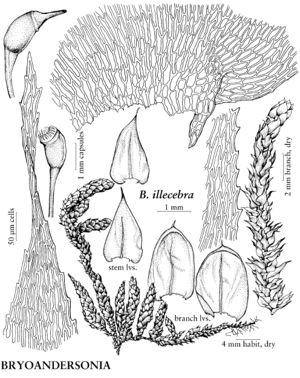Bryoandersonia illecebra
Bryologist 65: 139. 1963.
Plants rigid. Stems to 10 (–15) cm, branches to 15 (–30) mm; axillary hair apical cell obtuse, pale-brown. Stem-leaves broadly rounded to apex, 1.4–2.2 × 1–1.4 mm; base broadly rounded to insertion; alar region small, of 2–4 × 4–6 cells; laminal cells (30–) 40–55 (–70) × 5–7 µm; basal-cell walls incrassate, strongly porose. Seta 1.3–2.3 cm. Capsule 1.5 mm. Spores smooth.
Habitat: Soil in forest, on landslides, among moderately dense grasses in meadows and lawns, rock, tree bases
Elevation: low to moderate elevations (10-1000 m)
Distribution

Ont., Ala., Ark., Conn., Del., D.C., Fla., Ga., Ill., Ind., Iowa, Kans., Ky., La., Md., Mass., Mich., Miss., Mo., N.J., N.Y., N.C., Ohio, Okla., Pa., R.I., S.C., Tenn., Tex., Va., W.Va.
Discussion
Bryoandersonia illecebra is locally common in eastern North America, especially in the more southern states, and the species can be expected in northeastern Mexico. The species is easy to recognize by its concave leaves and julaceous shoots. In exposed habitats, the plants often grow as dense clusters of evenly julaceous shoots. In more mesic environments, the stems are more elongate, with spaced branches that have strongly concave leaves only near their ends, while proximally, leaves are ovate-triangular and only slightly concave. Its growth pattern is much like Myuroclada, a monotypic genus widespread in East Asia and found in North America only in Alaska; thus, confusing them is unlikely. Pseudoscleropodium purum has some similarity with Bryoandersonia when depauperate, but differs in its regular pinnate branching, growth in rather dense tufts, and only slightly serrate distal leaf margins. Sporophytes are found rarely in Bryoandersonia.
Selected References
None.
Lower Taxa
"long" is not a number."broad" is not a number.
